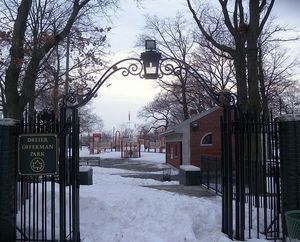People complain that the problems of our society are too overwhelming for one person to do anything about. One person may not be able to change the world but one act by a few good people can affect a wave of change throughout a state and a country. This was the result of a plea for justice set in motion on February 1, 1960, when four African-American students from North Carolina A&T; State University sat down at a “whites only” lunch counter in Woolworth’s.
I’ve been to that Woolworth’s and ordered something from that lunch counter. I was a freshman at Bennett College in Greensboro, North Carolina in 1988-twenty-eight years after someone who looked like me sat down at that lunch counter for the first time. When I walked into that store, I had no idea of the events that had allowed me to buy a piece of apple pie that fall day, but I soon learned. What follows is an account of how my city, became the center of a new civil rights movement.
The four young men, Franklin McCain, Joseph McNeil, Ezell Blair, Jr., and David Richmond lived on the same floor of the dorm at North Carolina A&T; State University. Two of the friends were born and raised in Greensboro. One was from Wilmington but transplanted to New York and the other was born and raised in Washington, D.C. On the night of January 31, 1960, they decided that something needed to be done about the problem of segregation that still existed in the South.
Each of the young men had been affected by the 1955 lynching of Emmett Till. For those of you who don’t know about Emmett Till, his plight garnered media attention at his open casket funeral held in Chicago, Illinois, at the request of his mother, Mamie. Emmett Till was a fourteen-year old boy who was killed for allegedly whistling at a white woman in a store in Money, Mississippi. He was dragged from his uncle’s home in the middle of the night, beaten, shot in the head, and thrown in the river with a seventy-five pound cotton gin fan around his neck. The men responsible were acquitted of his murder.
The four A&T; students had had enough. It was not enough that Blacks were treated like second-class citizens, they could also be murdered at will and the courts would do nothing to correct the injustice. Someone had to try to do something. So, on February first, Franklin, Joseph, Ezell, and David walked into the Woolworth’s store in downtown Greensboro and sat down at the lunch counter.
The white customers were probably shocked. They surely assumed that the four were from out of town and didn’t know “the rules”. Someone may have pointed out to them that it was a “whites only” lunch counter. As if the words had fallen on deaf ears, the four continued to sit at the counter without saying a word. No one knew what to do, so they closed the store early. More determined than ever, the four returned the next day and sat at the counter again. Other students from North Carolina A&T; State University joined the sit-in. The news network got wind of what was going on and moved in. The number of sit-in demonstrators increased each day and soon the movement spread to lunch counters in nearby cities. The demonstrations spread to fifty-four cities in nine states.
Back in Greensboro, the city was deadlocked. Negotiations with store owners to get them to integrate their lunch counters failed and the sit-ins continued. Finally, in July of 1960, over five months after the sit-ins started, the F.W. Woolworth Company integrated their lunch counters in Greensboro. The civil rights movement was alive and well and residing in North Carolina.
Franklin McCain, Joseph McNeil, Ezell Blair, Jr. (who later became known as Jibreel Khazan), and David Richmond became symbols of the revitalized civil rights movement. As a result, life after college was difficult for them. Everyone in Greensboro knew their names and labeled them troublemakers. All of the men left the city and one, David Richmond, returned. He remained in the city until his death in 1990. A documentary entitled, “February One”, recounting the lives of these men as they fought against racial injustice, has aired on PBS on the program, Independent Lens.
The Woolworth’s store where the sit-in movement began closed not long after I came to college in 1988. The cross street where the store was located has been named February One Place. The Woolworth’s building was bought by the group Sit-In Movement, Incorporated and renamed the International Civil Rights Center and Museum. The museum will chronicle the history of the “Greensboro Four”, as the four young men became known, and educate the public on the importance of actions like the sit-in movement in changing the course of American history. A portion of the lunch counter is now a part of an exhibit in the Smithsonian Museum of American History in Washington, D.C. and the Greensboro Historic Museum. The original stools where the Greensboro Four sat will be displayed in the civil rights museum when it is finished. Sit-In Movement, Inc. is still raising funds to complete renovations on the building.
My husband and sons have attended the February One Breakfast held on that day each year at North Carolina A&T; State University to honor the Greensboro Four. A special time for them was when the statue honoring the four young men was unveiled on A&T;’s campus. My children have learned that when good men do something, the world can change a little bit at a time. It is our duty as citizens of this country, to remember and learn from their sacrifice, not just during Black History Month, but every month of the year. So, spread the word.





